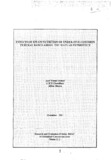Effects of EPI on nutrition of under-five children In rural Bangladesh: the Matlab experience
Citation
Ahmed, S. M., Bhuiya, A., & Chowdhury, A. (1995, December). Effects of EPI on nutrition of under-five children In rural Bangladesh: the Matlab experience. Research Reports (1995): Health Studies, Vol - XVIII, 1–16.Abstract
Objectives: This study was done to explore the effect of immunization (as specified in
EPI) on under-five children's nutritional status in a rural area of Bangladesh.
Methods: The data for this study originated from a sub-sample of a baseline survey
conducted in 60 DSS villages of Matlab thana during 1992. :MUAC, height and weight of
992 children between the age of one to five years were measured using standard technique
and socioeconomic information were collected from their mothers using a set of pre-tested
structured questionnaire. The level '-2 Z score ' was taken as the cut-off point for
"stunting" and the value of less than 125 mm of MUAC for "severely malnourished"
children.
Results: Both bi-variate and multi-variate analyses revealed the significant role of
immunization status in affecting less severe acute malnutrition (NillAC) in poor households
which was not seen in the better-off households. Again, immunization status appeared not
to have any effect on 'stunting' i.e., long-term nutrition. Wnen considering long-term
nutrition (Ht/age), both bi-variate and multi-variate analyses identified mother's education
and number of dwellings in the household to be significant influencing factors for the
BRAC eligible children. Also, completely immunized children from BRAC non-eligible
households were found to have significantly better anthropometric indices than their
counterparts . . .<\nother interesting finding was the sex difference seen among the better-off
households. Girls in these households were much less likely to be completely immunized,
and more likely to be acutely malnourished. This issue needs further exploration for a
better understanding of the households' gender dynamics.
Conclusions: EPI immunization has some beneficial, if only margina~ impact on the acute
nutritional status of the poor children only. It has no effect on chronic nutrition, for which
socioeconomic factors seems to play a greater role. Differences exist across socioeconomic
status of the household and sex of the children.

